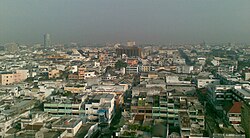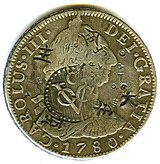Sumatra
Sumatra (in Indonesian, Sumatera) is a large island in Southeast Asia located in the waters of the Indian Ocean and belonging to Indonesia. With an area of 473,605 km², it is the sixth largest island in the world and the largest island in Indonesia.
In the year 2020 it had a population of 58,557,211 (22% of the total population of Indonesia) and the largest city was Medan with 2,109,330 inhabitants. 87% of the Sumatran population is believed to be Muslim.
Sumatra has a wide variety of plant and animal species, but has lost almost 50% of its rainforest in the last 35 years and has many critically endangered species, such as the Sumatran tiger, Sumatran rhino, and Sumatran orangutan.
There is evidence of colonist settlement on Sumatra from around 500 B.C. C. and several important kingdoms flourished on the island. I Ching, a Chinese Buddhist monk, studied Sanskrit and spent four years of his life working in Palembang. The traveler Marco Polo visited the island in 1292.
Etymology
Sumatra was known in ancient times by the Sanskrit names of Swarnadwīpa ("Golden Island") and Swarnabhūmi ("Golden Land"), probably due to the gold deposits of the island's highlands. The first work to mention the name Sumatra was the Srivijayan name for Haji (king) Sumatrabhumi ("The King of the Land of Sumatra"), who sent an emissary to China in 1017. Arab geographers, between the 10th and 13th centuries, called the island Lamri (Lamuri, Lambri or Ramni), referring to a kingdom near present-day Banda Aceh, which was the first to be landed by its traders.
At the end of the XIV century the name Sumatra became popular, referring to the Kingdom of Samudra Pasai, which was a rising power, until it was replaced by the Sultanate of Aceh. Sultan Alauddin Shah of Aceh, in letters written in 1602 to Queen Elizabeth I of England, referred to himself as "King of Aceh and Samudra". The word, also in Sanskrit for Samudra, (समुद्र), means "meeting together of the waters, sea or ocean".
After the arrival of Islam in the 13th century century, the island was also called by Muslim travelers as < i>Andalas, a word derived from Al-Andalus, to compare the flourishing Islamic kingdoms of Sumatra in the far east of the Muslim world as a reflection of Muslim Spain in the far west. European writers in the 19th century discovered that the indigenous people had no name for their island.
Geography
The major axis of the island, about 1,790 km long, runs roughly northwest to southeast, crossing the equator near the center. At its widest point the island is 435 km. The interior of the island is dominated by two geographical regions: the Barisan Mountains in the west, and the swampy plains in the east.
The island is in the northwestern part of the Malay Archipelago and is part of the larger Sunda group of islands. The island is in the Indian Ocean and is bounded by
- to the southeast, the strait of the Sonda, which separates it from the island of Java;
- to the north, the Strait of Malacca, which separates it from the Malaya Peninsula;
- To the east, the strait of Karimata separates it from the great island of Borneo;
- To the west, the Strait of Mentawai separates it from the small islands of Mentawai, and other small straits separate it from the islands of Simeulue, Banyak Islands, Nias, Batu Islands, Mega and Enggano.
The backbone of the island is the chain of the Barisan Mountains, with the highest point being the active volcano Mount Kerinci (at 3,805 m), which lies roughly at the midpoint of the range. The volcanic activity of this region endows it with fertile soil and beautiful landscapes, for example, the surroundings of Lake Toba. It also contains deposits of coal and gold. The volcanic activity is due to Sumatra being on the "Pacific ring of fire", which is also the reason why Sumatra has had some of the most powerful earthquakes ever recorded: in 1833, 2004, 2005 and September 2007.
To the east, several large rivers carry silt from the mountains and form the vast lowlands, a region dotted with pools and swampy areas. Despite being mostly unsuitable for cultivation, today the area is of great economic importance to Indonesia, producing oil "above and below ground" - palm oil and petroleum.
Sumatra is the largest coffee producer in Indonesia. Some small farmers grow Arabica coffee (Coffea arabica) in the highlands, while Robusta (Coffea canephora) is found in the lowlands. Arabica coffee from the Gayo, Lintong and Sidikilang regions is usually processed using the Giling Basah (wet peeling) technique, which gives it a heavy body and low acidity.
Most of Sumatra used to be covered in tropical rainforest, home to species like the orangutan, tapir, Sumatran rhino, and Sumatran tiger, and some unique plants, like the rafflesia. Unfortunately, economic development coupled with corruption and illegal logging have severely threatened its existence. Not even protected areas have been spared from destruction.
The island, by altitude, is the fifth highest in the world and the third in the Indonesian archipelago.
Administrative division
The island of Sumatra belongs to Indonesia and is administratively divided into the following provinces (some include nearby smaller islands):
- Aceh (capital: Banda Aceh);
- Bangka-Belitung (capital: Pangkal Pinang);
- Bengkulu (capital: Bengkulu);
- Jambi (capital: Jambi);
- Lampung (capital: Bandar Lampung);
- Riau (capital: Pekanbaru);
- Riau Islands (capital: Tanjung Pinang);
- Western Sumatra or West SumatraSumatera Barat(capital: Padang)
- Southern Sumatra or South SumatraSumatera Selatan(capital: Palembang);
- Northern Sumatra or North SumatraSumatera Utara(capital: Medan).
Larger Cities
The largest urban areas in Sumatra by population, based on 2009 estimates by The World Gazetteer, are as follows:
| Post | City | Province | Population |
|---|---|---|---|
| 1 | Medan (provincial capital) | Northern Sumatra | 1 770 000 |
| 2 | Palembang (provincial capital) | Southern Sumatra | 1 277 000 |
| 3 | Padang, provincial capital | Western Sumatra | 986 000 |
| 4 | Bandar Lampung (provincial capital) | Lampung | 940 000 |
| 5 | Pekanbaru (provincial capital) | Riau | 796 000 |
| 6 | Jambi (provincial capital) | Jambi | 457 000 |
| 7 | Bengkulu (provincial capital) | Bengkulu | 386 000 |
| 8 | Banda Aceh (provincial capital) | Aceh | 295 000 |
| 9 | Pematang Siantar | Northern Sumatra | 205 000 |
| 10 | Lubuklinggau | Southern Sumatra | 201 000 |
Demographics
Sumatra is not very densely populated (45 million people in an area larger than Germany). The most populous regions include most of Sumatra Utara and the central highlands in Sumatra Barat, while the largest urban centers are Medan and Palembang.
The population is of Malay origin made up of many different tribes, speaking 52 different languages. Most of these groups, however, share very similar traditions and the different languages are closely related. The Malay-speaking population dominates the east coast, while the population in the south and central interior speak Malay-related languages such as Lampung and Minangkabau. The highlands of North Sumatra are inhabited by the Bataks, while the northern coast is dominated by the Aceh. Chinese ethnic minorities are also present in urban centers.
A majority of the population in Sumatra are Muslims. Most of the Bataks in the center are Protestant Christians—the religion was spread by the Dutch. The rest follow Hinduism, Buddhism, Catholicism, and traditional Chinese beliefs.
History
An ancient name for Sumatra was Swarna Dwipa, or Isle of Gold, apparently based on the fact that mines in the highlands of Sumatra had been exporting gold since ancient times. early.
With its location on the trade route between India and China, various trading villages flourished, especially on the east coast, and were influenced by Indian religions. The most notable of these is the Srivijaya, a Buddhist monarchy centered in what is now Palembang. Dominating the region through trade and conquest during the 7th to 9th centuries, the kingdom helped spread Malay culture throughout Sumatra, the Malay Peninsula and western Borneo. The empire is thalassocratic, however, meaning that it did not extend its influence very far from the coastal zone.
Srivijaya's influence waned in the 11th century century. The island was subject to conquest from the Javanese kingdoms, first Singhasari and later Majapahit. At the same time, Islam traveled as far as Sumatra, spreading through contacts with Arab and Indian traders.
By the end of the 13th century, the monarch of the kingdom of Samudra (now in Aceh) had converted to Islam. Ibn Battuta, who visited the kingdom during his trip, pronounced the name of the kingdom "Sumatra", hence the name of the island. Samudra was succeeded by the powerful Sultanate of Aceh, which survived into the 20th century.
In 1509 the Portuguese arrived on the island under the orders of Figueira. And in 1511 after the conquest of Malacca, the Portuguese founded some settlements, but the sultans of Achim and Padang destroyed these colonies in 1523. The Dutch navigator Hautman had tried to establish relations in 1599 with Achim, but this effort cost him his life. In 1600 the Dutch East India Company seized some parts of the island, establishing the Djambai factory in 1618, and two years later others in the kingdom of Palembang. In 1662 the Dutch Company imposed a treaty with the queen of Achim with the aim of forming a protectorate in that region. In this way, the company reserved the exclusive trade on the southwest coast of the island. Later, between 1664 and 1669, the factories of Padang, Baros, Adjis and Lampong were built. Meanwhile the English, who already in 1685 settled in Benkulen, had to endure numerous armed conflicts with the Dutch and natives of the place. In the year 1811 the Dutch employees and soldiers of the Palembang fort were assassinated. This attack committed by the people of the Sultan of Palembang resulted in a bloody war. The struggle lasted until 1821, when the sultan lost his freedom and all his states. In 1824 England relinquished its possessions of Sumatra, in exchange for the territory that the Netherlands had in Malacca. In 1835 the peace on the island was again disturbed as a result of the predictions of three pilgrims from Mecca. The Dutch government put an end to the insurgents, and this war definitively ruined the already diminished political power of the Menangkabo sultans. In 1850 Palembang was subdued, in 1856 the province of Lampong, in 1857 the countries of Djambi and Indraguiri, in 1861 Labong and from 1864 to 1868 the territories of Lake Rendau and Pasunrah. The Netherlands waged a war until 1874 with the aim of subduing the kingdom of Achim, protected by England until 1872, and ceded in exchange for the possessions of Guinea.
Economy during the Dutch occupation
During the occupation of this territory by the Dutch East India Company (Vereenigde Oostindische Compagnie or VOC) the use of different foreign currencies was common. To guarantee its circulation, different countermarks were stamped on pieces of 8 Spanish reales, 5 French francs and talers of María Teresa I of Austria. The countermark consisted of a circular punch of 14 to 17 millimeters bearing the initials "VOC".
Flora and fauna
- Sumatra Tiger
- Orangutan
- Sumatra Rinoceronte
- Tapir malayo
- Jabalí barbudo
- Gibón agil
- Canao bicorne
- Martin blue fisherman
- Crazy clown
- Rafflesia
- Orang Pendek
Contenido relacionado
Kingdom of Iberia
Watershed
Maracay
Machu Picchu base
Wadati-Benioff zone


